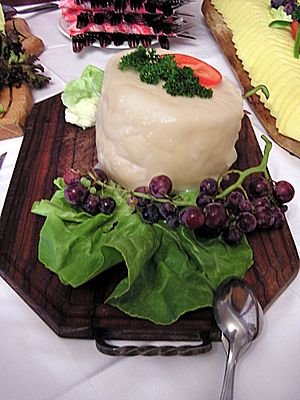Sura Kees facts for kids
Quick facts for kids Sura Kees |
|
|---|---|
 |
|
| Other names | Vorarlberger Sauerkäse, Montafoner Sauerkäse |
| Country of origin | Austria |
| Region | Montafon (Vorarlberg) |
| Source of milk | Cows |
| Texture | soft |
| Fat content | low fat (1-10%) |
| Weight | ½ kg or 2 kg |
| Certification | PDO |
Sura Kees is a special kind of cheese from the Montafon valley in Vorarlberg, Austria. Its name means "sour cheese" in the local language. It is also known as Vorarlberger Sauerkäse or Montafoner Sauerkäse. This cheese is very low in fat. It is made from skim milk, which is milk with all the cream removed. This skim milk is left over from making butter. Sura Kees is quite similar to the Tyrolean Grey Cheese.
Making Sura Kees has been an important part of life in Vorarlberg for hundreds of years. This tradition is so special that the cheese has a PDO status. This means it can only be called Sura Kees if it comes from this specific region and is made in the traditional way.
People usually enjoy Sura Kees with vinegar, oil, and onions. You can also eat it plain on black bread or with potatoes.
How Sura Kees is Made
Making traditional Montafoner Sura Kees starts with fresh milk. First, the milk is filtered. Then, it is poured into special wooden containers called "Brenten". The milk sits there for one or two days. During this time, the cream separates and rises to the top.
The cream is then used to make butter. The skim milk, which is left behind, is the main ingredient for Sura Kees. This skim milk is poured into a wooden tub called a "Zuber" to become more acidic. After that, it goes into a copper pot called a "Kessi" and is heated. The temperature must not go above 40°C (104°F).
The heated milk forms a solid mass called "Bolma," which is the cheese curd. This curd is carefully scooped out with a special ladle, called a "Bolmakelle." It is then placed into a unique mold called a "Käsker." The cheese curd presses itself down with its own weight. It stays in the mold for about 24 hours until it becomes a firm block.
The cheese is usually turned twice while in the mold. This helps any extra liquid, called whey, to drain away. Once it is firm, the cheese block is taken out of the mold. It is rubbed with salt, and sometimes a little paprika for flavor. Then, it is stored in a cellar to mature.
After about three weeks, the outside of the cheese is washed. The cheese blocks are then placed on wooden racks. They ripen for another four to six weeks in a special room kept at 18 to 20°C (64 to 68°F). During this time, a glassy, greasy layer called "Muffna" forms on the outside. This layer gets thicker as the cheese ages and gives Sura Kees its special taste. The cheese ripens from the outside in.
The Story of Sura Kees
Making sour milk cheese is a very old tradition. People have known how to make it for about 7,000 years! The Sumerians, an ancient civilization, accidentally discovered it. They found that leftover milk would thicken and turn into a solid block over time. This is how the first sour milk cheese was created. The knowledge of making sour milk cheese then spread across Europe, thanks to the Romans.
Thousands of years ago, the Celts lived in Vorarlberg. They were pioneers in making cheese in the Alpine mountains. The Celts brought the "cheese maker" to Vorarlberg. This "Käsker" is the same type of mold still used today to press the cheese on the mountain pastures.
In the 1600s, many regions started making a different kind of cheese called rennet cheese. Rennet cheese was easier to store and transport. This made it better for selling in new cities. But in the Montafon valley, people kept making sour milk cheese.
In the 1960s, many cheese dairies in Montafon closed down. Cheese making became focused on just a few dairies in the valley. People also started to forget about traditional foods. This led to a decline in local cheeses, including Sura Kees.
However, in the early 1990s, people began to appreciate old traditions again. Sura Kees became more popular, especially with younger people. Farm shops started selling it, and the tourism industry saw it as a great local product. The recipe for Sura Kees is one of the oldest in the German-speaking world. In 1997, a group called "Montafon bewusst-er-leben" was formed. Their goal was to help market local farm products. In 2007, this group worked hard to bring Sura Kees back into the spotlight.

